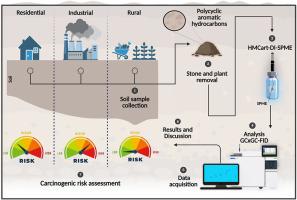评估巴西城市土壤中的多环芳烃污染:生态友好型微萃取法用于来源识别和风险评估
IF 7.3
2区 环境科学与生态学
Q1 ENVIRONMENTAL SCIENCES
引用次数: 0
摘要
多环芳烃(PAHs)被认为是对环境和人类健康产生重大影响的持久性有机污染物。本研究调查了巴西Divinópolis不同土地利用区域土壤中的多环芳烃污染,使用了一种新的分析方法,该方法将直接浸泡固相微萃取(DI-SPME)与亲水微孔盒(HMCart)和综合二维气相色谱(GC×GC/FID)相结合,以增强检测和定量。hmart - di - spme方法结合GC×GC/FID具有较好的分析性能,检出限低(1.0 ~ 6.8 μg kg-1),回收率高(93.67 ~ 109.67%),精密度高(RSD为6.16 ~ 15.76%)。ΣPAH的范围为141.77 ~ 1133.07 μg -1,其中工业区域的浓度最高,超过800 μg -1。苯并[a]芘当量(BAPeq)在大部分样品中为63.95 μg kg-1,在工业地区为691.79和814.40 μg kg-1,超过了210 μg kg-1的安全阈值。来源分析显示,多环芳烃主要分布在商业和居民区,而工业地区则表现出强烈的热成因特征,主要与化石燃料燃烧和纺织工业活动有关。同分异构体比、多变量分析和正矩阵分解(PMF)模型证实了多环芳烃源的空间变异,强调了人为因素对污染水平的影响。结果强调了城市工业环境中多环芳烃污染持续监测的重要性,并验证了HMCart方法作为法医环境分析的可持续和有效的替代方法。本文章由计算机程序翻译,如有差异,请以英文原文为准。


Assessing PAH contamination in Brazilian urban soils: Eco-friendly microextraction for source identification and risk evaluation
Polycyclic aromatic hydrocarbons (PAHs) are considered persistent organic pollutants that have a significant impact on the environment and human health. This study investigates PAH contamination in soils across various land use areas in Divinópolis, Brazil, using a novel analytical approach that integrates direct immersion solid-phase microextraction (DI-SPME) with a hydrophilic microporous cartridge (HMCart) and comprehensive two-dimensional gas chromatography (GC × GC/FID) for enhanced detection and quantification. The HMCart-DI-SPME method combined with GC × GC/FID demonstrated outstanding analytical performance, achieving low detection limits (1.0–6.8 μg kg−1), high recoveries (93.67–109.67 %), and good precision (6.16–15.76 % RSD). The ΣPAH ranged from 141.77 to 1133.07 μg kg−1, with the highest levels observed in industrial areas, surpassing 800 μg kg−1. Benzo[a]pyrene equivalent (BAPeq) values ranged from 63.95 μg kg-1 in most samples to 691.79 and 814.40 μg kg−1 in industrial areas, exceeding the safety threshold of 210 μg kg−1. Source apportionment analysis revealed a predominance of petrogenic PAHs in commercial and residential areas, whereas industrial areas showed a strong pyrogenic signature, primarily related to fossil fuel combustion and textile industry activities. Isomeric ratios, multivariate analysis and Positive Matrix Factorization (PMF) model confirmed the spatial variation of PAH sources and highlighted the anthropogenic influence on contamination levels. The results emphasize the importance of continuous monitoring of PAH pollution in urban-industrial environments and validate the HMCart approach as a sustainable and effective alternative for forensic environmental analysis.
求助全文
通过发布文献求助,成功后即可免费获取论文全文。
去求助
来源期刊

Environmental Pollution
环境科学-环境科学
CiteScore
16.00
自引率
6.70%
发文量
2082
审稿时长
2.9 months
期刊介绍:
Environmental Pollution is an international peer-reviewed journal that publishes high-quality research papers and review articles covering all aspects of environmental pollution and its impacts on ecosystems and human health.
Subject areas include, but are not limited to:
• Sources and occurrences of pollutants that are clearly defined and measured in environmental compartments, food and food-related items, and human bodies;
• Interlinks between contaminant exposure and biological, ecological, and human health effects, including those of climate change;
• Contaminants of emerging concerns (including but not limited to antibiotic resistant microorganisms or genes, microplastics/nanoplastics, electronic wastes, light, and noise) and/or their biological, ecological, or human health effects;
• Laboratory and field studies on the remediation/mitigation of environmental pollution via new techniques and with clear links to biological, ecological, or human health effects;
• Modeling of pollution processes, patterns, or trends that is of clear environmental and/or human health interest;
• New techniques that measure and examine environmental occurrences, transport, behavior, and effects of pollutants within the environment or the laboratory, provided that they can be clearly used to address problems within regional or global environmental compartments.
 求助内容:
求助内容: 应助结果提醒方式:
应助结果提醒方式:


